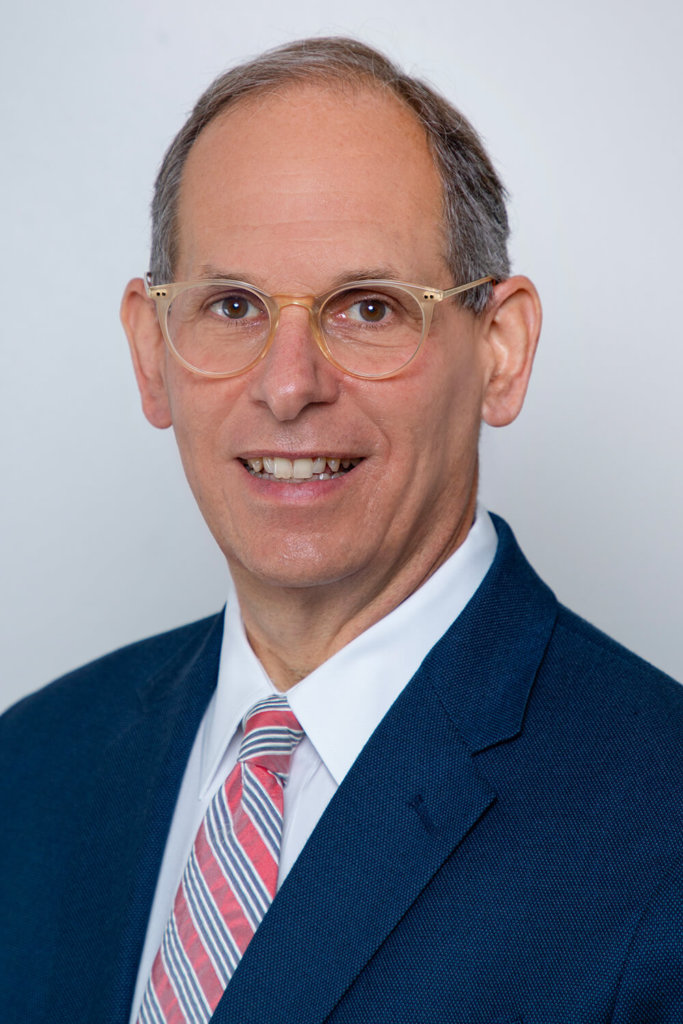News
From day one, Dr. Neil Schluger ’77 was on the front lines of the COVID-19 pandemic. In early March, the first patient with COVID in the New York City area was transferred to Columbia University Irving Medical Center, where Dr. Schluger was Chief of the Division of Pulmonary, Allergy and Critical Care Medicine.

The man, who arrived in critical condition, was cared for by members of Dr. Schluger’s team. “For the first few days in March,” Dr. Schluger said, “we had only a few COVID-19 patients in the hospital, but by mid-March, cases began to accumulate very rapidly and threatened to overwhelm the hospital’s resources. By early to mid-April, our hospital and all others in New York became almost exclusively COVID facilities, and the numbers of patients with severe illness was unlike anything I had experienced in 35 years as a physician in New York City. At the peak of the epidemic in New York, we had over 620 COVID patients in our hospital, of whom 230 were on mechanical ventilation. Many parts of the hospital were turned into makeshift intensive care units, and we were forced to reinvent how the hospital operated and how it was staffed on almost a daily basis.”
The Signs Were There
The pandemic had not arrived without warning. “In early 2020, I was aware of the reports from China and elsewhere of a novel, highly contagious infectious disease beginning to spread around the world,” he said. “I was traveling for professional reasons in Asia and Africa in February 2020 and I saw many people wearing masks while in airports and on airplanes. In the United States at that time, despite clear warnings about what was happening elsewhere, there seemed to be little preparation or education aimed at the public about what might happen and how to prepare.”
The Pandemic Floods Hospital with Patients
Columbia’s doctors, nurses, and other health care workers worked heroically through the months. “Almost everyone I knew in the hospital was working at least 16 hours a day, 7 days a week throughout March, April, and much of May,” Dr. Schluger recalled. “The atmosphere in the hospital was unusual—we were full with very sick patients, but because of infection control measures, there were no visitors, and all routine outpatient visits were suspended and converted to tele-health…there was a strange and almost eerie quiet in many parts of the medical center. Levels of stress, anxiety, fatigue, and depression were quite high among the staff. We were treating an illness that we had not encountered previously, and at a time that the system was nearly overwhelmed with patient care duties. Resources were stretched very thin and we had to contemplate things that horrified us, such as rationing of ventilators and dialysis; fortunately, this never happened, although just discussing it was a source of distress for many.” The medical staff deeply appreciated the many expressions of gratitude and support from the general public and physician volunteers from all over the country. “On the other hand,” Dr. Schluger said, “the lack of a coordinated response and plan from the federal government was disheartening and it made us feel at times that we were on our own during the crisis.”
In May, colleagues at Columbia and Dr. Schluger published an important paper about hydroxychloroquine, showing that there was no association between the administration of the drug and better outcomes in patients with COVID-19, in the New England Journal of Medicine.
No Time for Complacency
Although the levels of infection are low in New York now, Dr. Schluger encourages the wearing of face coverings and social distancing. “It’s very encouraging to see most of New York State open right now without an increase in COVID-19 cases,” he said. “I personally would be very careful with certain activities such as indoor dining. I am concerned that when cold weather comes and people can’t enjoy themselves out of doors, infection rates may begin to rise again.”
“It’s a simple act of compassion and citizenship to put on a mask, and there is, or should be, nothing political about it.”
He said he is both surprised and disappointed to see infection rates still high in many parts of the country. “Having seen how bad things became in New York, elected officials and ordinary citizens around the country should be well aware of the price to be paid by ignoring science and refusing to use simple and inexpensive measures such as mask wearing that can both save lives and help keep a great deal of the economy open. It’s a simple act of compassion and citizenship to put on a mask, and there is, or should be, nothing political about it.”
Slow Summer Return to “Normalcy”
In July, Dr. Schluger took on the role of Chairman of the Department of Medicine at New York Medical College, where the training program for interns and residents is returning to normal, “albeit with universal mask wearing and social distancing for meetings and lectures.”
Vaccine on Horizon
Dr. Schluger counsels patience. “Having a vaccine ready for distribution to the general public by the end of 2020 will be something of a miracle,” he said, “and I think it’s unlikely to happen. It usually takes years to develop and test a novel vaccine to assure its efficacy and safety. However, there is an enormous amount of scientific talent and activity focused on vaccine development at the moment, and early phase results of clinical trials have certainly been encouraging. There is a reasonable chance that we might have a useful vaccine ready for mass production in early-mid 2021.”
The Future
Dr. Schluger describes himself as an optimist, but acknowledges this has been a challenging time, “not least because political leadership at the federal level during this crisis has been so disorganized, misleading, dismissive of science, and divisive.”
“On the other hand,” he said, “we have learned a great deal about this disease, and in places like New York we’ve had good leadership and citizens who are for the most part doing what they need to do. If we do what we know we have to do, and prepare for future epidemics, I’m optimistic that we’ll get back to normal in the not-too-distant future.”



